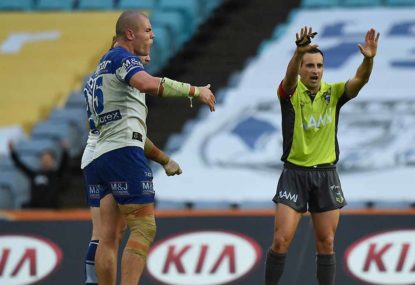For many years, Cronulla used a shark mascot named MC Hammerhead. His namesake’s biggest hit ‘You Can’t Touch This’ should be the NRL’s theme song this week.
Touching a referee is not the greatest crime on a rugby league field, although it has landed some players in hot water after Round 2.
David Klemmer of the Canterbury Bulldogs and James Roberts of the Brisbane Broncos have both been charged with contrary conduct for touching referees in their second round matches.
The NRL is clearly looking to eradicate any physical contact by players on referees during games. On the face of it that is a good policy. Referees should never touch a player and this respect should be reciprocated.
However, in its attempts to impose these standards on players, the NRL has come out of the weekend looking amateur at best and incompetent at worst. The reason is several other incidents have now been highlighted from the first two weeks of the competition, yet have seen no action taken by the game’s hierarchy.
The most notable of these was immediately after the Klemmer incident, where he placed an open hand on referee Ben Cummins’ chest. Before the penalty kick had been taken, Penrith Panthers forward Trent Merrin moved up to Cummins and pinched him on the hip.
Yet it wasn’t the NRL match review staff that nabbed Merrin – that was left to the video editors at Fox Sports, who revealed the vision over the weekend.
Adding to the embarrassment of having missed Merrin’s indiscretion so closely after an offence deemed punishable by two weeks’ suspension (due to Klemmer’s prior offences), the NRL then advised that since the game in question had already been reviewed, no further charges could be considered.
Come again? The round hasn’t even finished yet we can’t act on further evidence coming to light? That is a symptom of the NRL’s overarching desire to get things out of the way as soon as possible. Game over, game reviewed, on to the next game.
This same philosophy is now true with the referees reviewing their games. What was once done all on a Monday morning is now done as soon as possible after the game is complete. You can read about it here. The remainder of the weekend to reflect on the performance was no longer available.
No wonder Merrin escaped any scrutiny. Klemmer was spotted; case closed.
The point is that there seems to be uncertainty with how contrary conduct for touching referees is applied. It can’t be a ‘zero tolerance’ approach, because Wests Tigers half Mitchell Moses escaped punishment on Monday night when he touched referee Chris James.
Sure, James backed in to him from the side of the scrum and Moses used a Klemmer-type palm to move him away. James was at fault judging by the result. But that doesn’t fly with me.
When forming a scrum, a referee will only stand in one place – at the tunnel. Once he or she is satisfied the forwards are packed correctly, the referee will only move in one direction – immediately backwards.
So if Moses is standing behind a referee at the forming of a scrum, he’s failed at halfback 101.
Referees do a lot of work on positioning during the pre-season and throughout the year. In the same way NRL teams will simulate plays for their defensive structures, referees run through scenarios on the training field.
Attacking teams make line breaks, support runners are coming from every direction, defenders make cover tackles and through all that the referee needs to know where they need be.
Peripheral vision is essential.
Several former first grade players are part of the refereeing set-up including former coach Andrew Dunemann. They are clever football people and are valuable to the knowledge the referees gather in their development.
I raise this point about pre-season preparation for two reasons.
Firstly, I have read a lot of excuses for players touching referees over the years.
The most infamous was in 2011 when Johnathan Thurston poleaxed Matt Cecchin from behind as James Maloney crossed to score for the Warriors. Thurston was rightly charged with the offence and was looking at a two-week suspension.
Except, of course, the conspiracy theorists will remind you it was Origin time, and Thurston was at risk of missing the decider in Brisbane. So off he went to contest the charge and after 45 minutes of deliberating the judiciary returned a not-guilty verdict.
How Thurston escaped a ban that night is a mystery greater than Stonehenge.
Referees know where they need to be after line breaks. The training and practise of positioning has always been important but became paramount after Tony de las Heras collected Tony Carroll’s knee in 2009. Players know what jersey a referee wears too.
Secondly, and most importantly, the members of the match review committee have failed to do their preparation.
If the NRL wanted to crack down on any player touching a referee, then the month of trials that we saw prior to the weekend needed to be looked at forensically.
Many of those games were broadcast, including the All Stars game, the Charity Shield, Penrith versus Parramatta, at least one Warriors game – multiple camera angles available and it all should have been scrutinised.
I understand that trials don’t have the intensity of competition games, therefore the players are less likely to be heated enough to grab referees. However, even without going through the games myself, I would bet London to a brick there were instances of player contact with referees.
A month ago or more is when the line should have been drawn on contact with referees, based on the examples in the most recent matches.
Sadly, the NRL missed that opportunity, and it remains to be seen what the Bulldogs can salvage from David Klemmer’s appearance at the judiciary tonight.





























































































